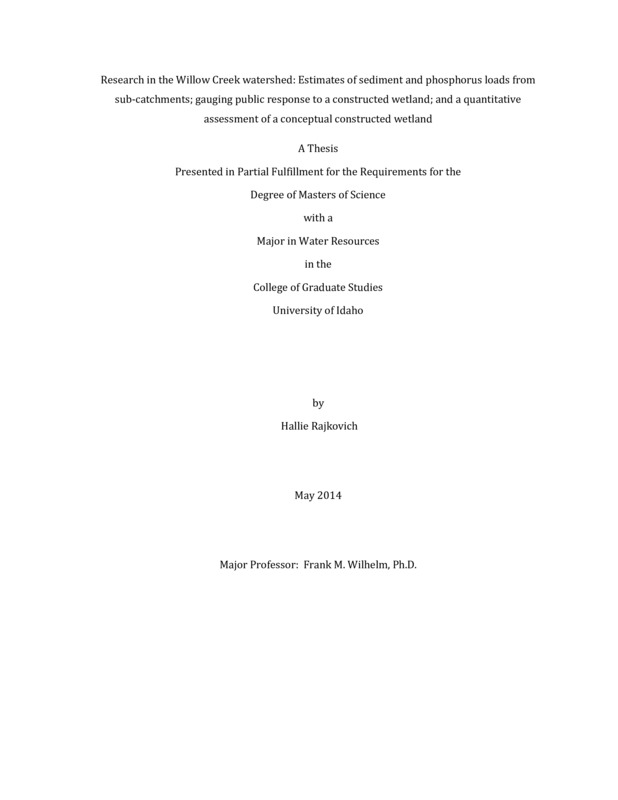Research in the Willow Creek watershed: Estimates of sediment and phosphorus loads from sub-catchments; gauging public response to a constructed wetland; and a quantitative assessment of a conceptual constructed wetland
Rajkovich, Hallie E.. (2014). Research in the Willow Creek watershed: Estimates of sediment and phosphorus loads from sub-catchments; gauging public response to a constructed wetland; and a quantitative assessment of a conceptual constructed wetland. Theses and Dissertations Collection, University of Idaho Library Digital Collections. https://www.lib.uidaho.edu/digital/etd/items/rajkovich_idaho_0089m_10227.html
- Title:
- Research in the Willow Creek watershed: Estimates of sediment and phosphorus loads from sub-catchments; gauging public response to a constructed wetland; and a quantitative assessment of a conceptual constructed wetland
- Author:
- Rajkovich, Hallie E.
- Date:
- 2014
- Keywords:
- Cyanobacteria Free water surface wetland Intercept social survey Nutrient loading P-k-C* model
- Program:
- Water Resources
- Subject Category:
- Hydrologic sciences; Environmental science; Fisheries and aquatic sciences
- Abstract:
-
Cultural eutrophication, the accumulation of excess nutrients (phosphorus (P) and nitrogen (N) in water bodies is often manifested in blooms of cyanobacteria, formerly known as blue-green algae. These blooms threaten water quality worldwide because they can produce a suite of the most potent toxins known to humans. Willow Creek Reservoir (WCR) in Heppner, OR experiences annual long-duration blooms of toxic cyanobacteria related to high loads of catchment-derived nutrients, primarily P. In my thesis, I identify and quantify the source of total phosphorus (TP) and total residue (TR, suspended and dissolved solids) from sub-catchments of the Willow Creek watershed. These loads were then combined with a modified export coefficient modeling approach to examine relations between land use and annual load. Contrary to my hypothesis, the majority of constituents were contributed by forested headwater sub-catchments, not agricultural areas in the lower reaches of the watershed. I also used an intercept survey to quantify residents and non-residents awareness of the annual toxic algae bloom and the interference such blooms have on their use of WCR, to examine how the construction of a wetland at the inlet of WCR would impact resident and non-resident use of WCR and to understand public's opinion of how the constructed wetland would be utilized. Overall, the majority of residents and non-residents were aware of the toxic algae bloom and supported a constructed wetland as a potential remediation strategy. Constructed wetlands have been used to target the reduction of P and reduce cyanobacteria. The effectiveness of TP and TR retention in a Free Water Surface (FWS) wetland system design at the inlet of the WCR was evaluated for water years 2010 and 2013. Because of limited space, the calculated removal of TP and TR mass in the wetland system was low and was therefore deemed not feasible. This study highlights the importance of basing management decisions on empirical data.
- Description:
- masters, M.S., Water Resources -- University of Idaho - College of Graduate Studies, 2014
- Major Professor:
- Wilhelm, Frank M
- Committee:
- Link, Tim E; Beutel, Marc W; Sanyal, Nick
- Defense Date:
- 2014
- Identifier:
- Rajkovich_idaho_0089M_10227
- Type:
- Text
- Format Original:
- Format:
- application/pdf
- Rights:
- In Copyright - Educational Use Permitted. For more information, please contact University of Idaho Library Special Collections and Archives Department at libspec@uidaho.edu.
- Standardized Rights:
- http://rightsstatements.org/vocab/InC-EDU/1.0/

